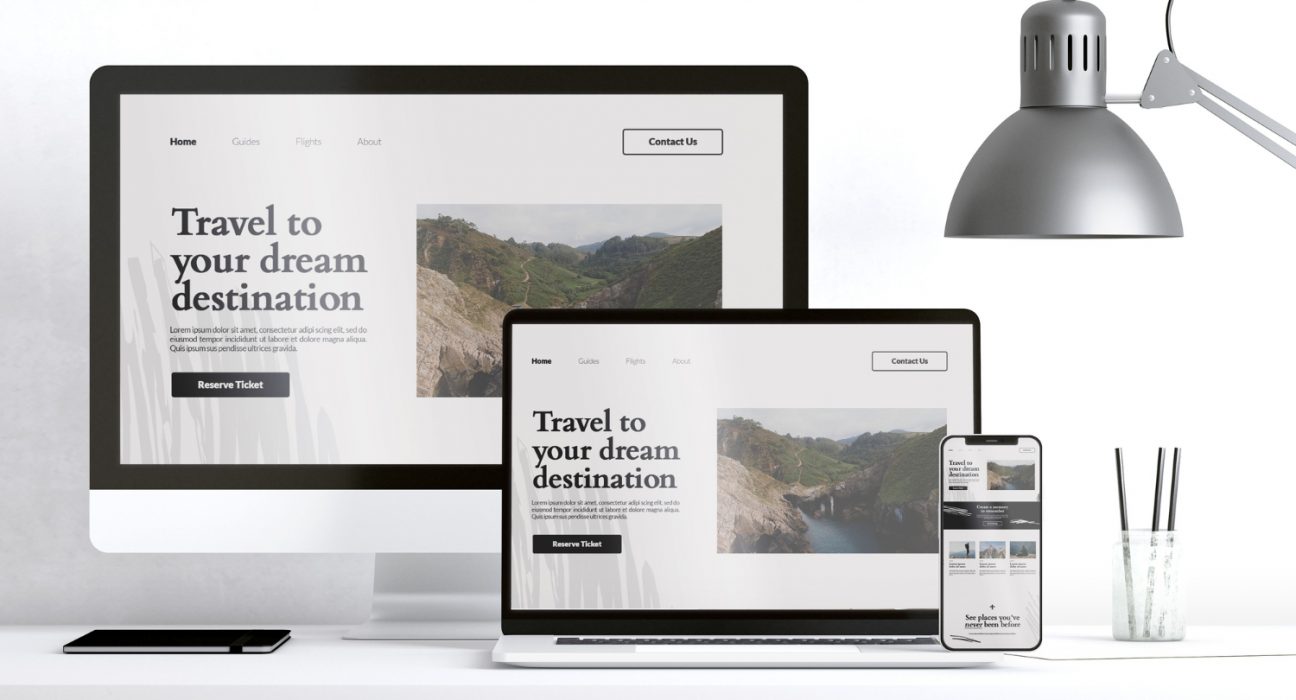Creating the Future: Building a Website in 2023 – Step by Step Guide

Introduction
In this digital era, a website is indispensable for any individual or business seeking to establish an online presence. Having a website can assist individuals such as small business owners, bloggers, and artists to establish connections with their target audience, develop their brand and attain their objectives. But with so many options and technicalities, creating a website in 2023 can seem overwhelming. However, with the right tools and knowledge, building a website is easier than ever.
According to WebFX, 94% of first impressions are related to your site’s web design.
In this blog post, we’ll be taking a step-by-step approach to help you create a website that is functional and visually appealing, optimized for search engines, easy to navigate and market. From conducting research and planning to SEO and marketing, we’ll cover everything you need to know to make your website a success in 2023 and beyond.
Step-by-Step
We’ll walk through creating a website from start to finish.
Determine the Purpose of Your Website
Determining the purpose of your website is one of the most critical steps in creating a website in 2023. It sets the foundation for all your decisions throughout the process, from design and layout to content creation and optimisation.
Here are a few examples of different purposes for a website and what they might entail:
- E-commerce: If you want to sell products or services online, your website must have a clear and easy-to-use layout, with prominent calls-to-action and easy navigation. You’ll also need to integrate a secure payment gateway and a shopping cart system.
- Blog or news website: If you’re looking to share information or knowledge on a particular topic, your website will need to be well-organized and easy to navigate, focusing on written content and a commenting system.
- Community-based website: If you’re looking to build a community around a particular topic, your website will need features such as user accounts, discussion forums, and possibly a messaging system.
- Business website: If you’re a business and you want to show your presence on the web, you’ll need a website that presents your business information, such as your products, services, about us, contacts us and more. Your website will also need to be professional-looking and easy to navigate.
- Portfolio website: If you’re a creative professional such as a designer, developer, or photographer, you’ll want a website that showcases your work in a visually appealing way and make it easy for potential clients to contact you.
It’s important to note that many websites can have multiple purposes. For example, a business website could have an e-commerce section and a blog.
Once you have a clear understanding of the purpose of your website, you’ll be able to make better decisions about the design, content, and features you’ll need. So as you create your website, keep your purpose in mind and refer back to it to ensure that your site stays on track.
Domain Registration
Once you determine the website’s purpose, you’ll need to register a domain. A domain is an address that people will type into their browser to access your website. The most common top-level domains (TLDs) include .com, .net, .org, and .info, but there are many new TLDs that you can choose from. When choosing a domain name, it’s essential to choose something easy to remember and relevant to your website’s purpose. It’s also good to check if the domain name is available on social media to secure your brand.
When it comes to registering a domain, there are many different companies that you can use, such as GoDaddy, Namecheap, and Network Solutions. Most of these companies will offer additional services such as web hosting, email hosting, and security certificates, making it convenient to get everything set up in one place.
Registering a domain is an important step in creating a website in 2023. With so many options available, it’s essential to take the time to research and choose the right one for your needs and skills. Remember that you should choose a domain name that’s easy to remember and relevant to your website’s purpose.
Choose a Platform
When it comes to platforms, there are several options available for building a website. The most popular ones include Content Management Systems (CMS) such as WordPress, Drupal, and Joomla, Static Site Generators (SSG) such as Gatsby, Next.js, and Jekyll, and building from scratch using programming languages such as HTML, CSS, and JavaScript.
CMS such as WordPress, Drupal, and Joomla are the most popular choices for building a website in 2023. These platforms offer a wide range of templates and plugins, making it easy to create a professional-looking site with minimal coding knowledge. They also have large developer communities, which means that if you run into any issues, you’ll be able to find help relatively easily.
SSG are becoming more popular for their performance and security benefit. However, it may require more coding knowledge.
Building from scratch gives you complete control over the website, but it can be more complex and require more development skills.
Choosing a platform is an important step in creating a website in 2023. With so many options available, it’s essential to take the time to research and choose the right one for your needs and skills.
Design and Layout
Design and layout are essential elements of any website, and in 2023, responsive design and a mobile-first approach will be more critical than ever.
When it comes to designing your website, you’ll need to consider several different factors, such as the overall look and feel of the site, the colours and
typography, the layout of the pages, and the navigation.
If you’re using a Content Management System (CMS) or a Static Site Generator (SSG), you’ll have access to a wide range of templates, which can make it easy to get a professional-looking site up and to run quickly. In addition, many of these templates will be responsive, adjusting to look good on different screen sizes and devices. However, it’s vital to ensure that your template is mobile-friendly.
If you’re building your site from scratch, you’ll have more control over the design but will need more coding skills. It’s essential to create a layout that is intuitive and easy to navigate, with a clear hierarchy of information. You’ll also need to ensure that your site is responsive and mobile-friendly to look and function well on different devices.
When it comes to colours and typography, it’s important to create a consistent look and feel throughout your site. In 2023, more and more websites will use web-safe fonts and typography for accessibility. So choose colours that are easy on the eyes, and use typography that is easy to read.
Design and layout are essential elements of any website in 2023. When designing your website, you’ll need to consider several factors, such as the overall look and feel of the site, the colours and typography, the layout of the pages, and the navigation. And most importantly, your website should be responsive and mobile-friendly. It’s important to create a layout that is intuitive and easy to navigate, with a clear hierarchy of information, ensuring the typography is accessible and easy to read.
Content Creation
Content creation is an important step in creating a website in 2023, as it’s the driving force behind the purpose and value of the site. It includes the text, images, and other media that will fill your site, and it can take a lot of time and effort to produce high-quality content.
When creating content for your website, it’s essential to start by thinking about the purpose of your site and the audience you’re trying to reach. This will help guide you in terms of the type of content you’ll need to create and the tone and style of that content.
Using a Content Management System (CMS) such as WordPress, you’ll have tools to help you create and organize your content. For example, you can use the built-in editor to write and format your text, and you’ll also be able to upload images and other media. It’s also common to use a headless CMS, a back-end solution that can be integrated with your website or application, which allows you to manage your content more efficiently.
Building your site from scratch will require you to manually write and format your content. However, it’s essential to keep in mind that in 2023, web accessibility will be more critical than ever. So you should ensure that your content is accessible to people with disabilities, using semantic HTML, providing alternatives for non-text content, and so on.
In terms of writing the content, it’s essential to write in a way that is easy to understand and engaging. And make sure that your content is well-structured and easy to navigate, using headings and subheadings, bullet points and lists, and so on. Including pictures and other forms of media is beneficial to separate the text and enhance the website’s visual appeal.
Content creation is essential in creating a website in 2023. It includes the text, images, and other media that will fill your site, and it can take a lot of time and effort to produce high-quality content. When creating content, it’s important to start by thinking about the purpose of your site and the audience you’re trying to reach and make sure that your content is well-structured, easy to navigate, and easy to understand. In addition, in 2023, accessibility is more important than ever, so ensure to provide alternative content for non-textual content and write in a way accessible to people with disabilities.
Optimisation
Optimization and deployment are the final steps in creating a website in 2023. After designing and building the content of your website, you’ll need to make sure that it is optimized for the web and then deploy it, making it live and available to the world.
Website optimization includes ensuring that your website loads quickly, is mobile-friendly, and is accessible to people with disabilities. In 2023, website optimization has become more critical than ever, with the increased use of Web Vitals as a ranking factor for SEO. Google has stated that web vitals such as loading speed, interactivity, and visual stability will be used as a ranking signal in search results, so it’s vital to ensure that your site is optimized for these factors.
Here are a few ways to optimize your website:
- Optimize images and other media: Ensure that all images and other media are correctly compressed and optimized for the web to minimize file sizes and improve loading speed.
- Minify CSS, JavaScript and HTML: Minifying your code removes unnecessary white space, comments, and other characters to reduce file size and improve page load times.
- Content Delivery Network (CDN): A CDN will help spread your website’s content to multiple regions, decreasing latency and increasing the website’s loading speed.
- Use Lazy loading: Lazy loading allows you to load images and videos only when needed, which can help improve the loading speed of your site.
- Use browser caching: Enabling browser caching allows visitors to your site to download and store frequently used files on their local device, which can help improve the loading speed of your site.
Deployment
After optimizing your website, the final step is to deploy it. This means making it live and available to the world. If you’re using a Content Management System (CMS), you’ll have tools to help you with this. Otherwise, you’ll need to upload your site’s files to a web server manually.
It’s crucial to ensure your site is deployed on a reliable and secure web hosting service.
Additional Steps
Creating a website involves several steps. While we’ve outlined the main steps above, other processes are also essential to consider when creating a website from start to finish.
Here are a few additional steps that can be included in the website-creation process:
Research and Planning
Research and planning are essential steps in creating a website from start to finish. It sets the foundation for all your decisions throughout the process, from design and layout to content creation and optimization.
Here are a few critical aspects to take into account when researching and strategising for your website:
- Target Audience: It’s essential to have a clear understanding of your target audience, including demographics such as age, gender, and location, as well as their interests and needs. By doing so, you will design a website that resonates with your intended audience and delivers the information and resources they require.
- Competitive Analysis: Analyze your competitors’ websites to understand what they’re doing well and what they’re not. Look at their sites’ design, layout, and content, and note any features or functionality you like or dislike. This will help you understand what is working in your industry and what you can do differently to stand out.
- Industry Trends: Keep an eye on trends and developments in your industry, as these can significantly impact the website most appropriate for your business. For example, an industry trend towards mobile-friendly websites might indicate that a mobile-responsive design would be a good choice for your site.
- Functionality: Determine the functionality you need for your websites, such as an e-commerce platform, a forum or a blog. This will guide you in picking the right platform to build your website.
- SEO research: Employ SEO techniques to examine the keywords related to your website and evaluate the level of difficulty associated with those keywords. Additionally, investigate the phrases or terms your target audience might use while looking for your products or services on the internet.
Once you’ve conducted your research, it’s essential to take the time to plan the structure and layout of your website. First, create a site map, which outlines the pages and content of your site, and use it as a guide during the design and development process.
In summary, research and planning are essential in creating a website; it allows you to understand your target audience, your competition, and your industry to make informed decisions on design, layout, content, and functionality. In addition, conducting research on SEO and planning the structure and layout of your website is also essential to ensure your website effectively reaches and converts your target audience.
Wireframing and Prototyping
Creating wireframes and prototypes are crucial stages in the process of website building. They help you to plan your site’s organization, content structure, and navigation prior to the design and development stages.
Wireframing is creating simple, low-fidelity visual representations of your site’s pages. Wireframes typically consist of simple shapes and lines and don’t include any colour, images or typography. Instead, their primary purpose is to help you plan your site’s layout and navigation and give you an idea of how different elements will be positioned on the page. Wireframes can be created using tools such as Balsamiq, Figma, and Adobe XD.
In contrast, prototyping is creating an interactive replica of your website, which emulates how it will look and operate once it’s finished. Prototypes are typically more detailed than wireframes and include more design elements such as colour, images, and typography. They can also have interactive features like buttons and links that simulate user interactions. These interactive elements allow you to see how the site will behave in different scenarios and can help you identify and fix any usability issues early in the development process. Like wireframes, prototypes can be created using tools such as Figma, Adobe XD, and InVision.
Wireframing and prototyping can help you identify and fix any usability issues early in the development process, saving you time and money in the long run. They also help you to get feedback from stakeholders and potential users, allowing you to iterate on your design and make any necessary changes before moving on to the development process.
In summary, wireframing and prototyping are essential steps in website creation. They allow you to plan your site’s layout, navigation, and content before beginning the design and development process. Wireframing focuses on the layout and navigation, while prototyping adds the interactive element and simulates how the site will look and function. These tools can save you time and money and allow you to get feedback before proceeding to the development process.
Search Engine Optimization (SEO)
Search Engine Optimization (SEO) involves enhancing your website to improve its position in the Search Engine Results Pages (SERPs), it is a vital stage throughout the website creation process, from the beginning till the end. Optimizing your website for search engines will enable you to amplify its online presence and attract more visitors to it.
SEO encompasses various elements, yet some of the most crucial ones are as follows:
- On-page optimization: On-page optimization refers to optimizing the content and structure of your website to make it more easily crawlable and understandable for search engine spiders. This includes optimizing page titles, meta descriptions, header tags, and internal linking.
- Content Optimization: Optimizing your website’s content to target specific keywords while still providing value to the user is one of the most important aspects of SEO. This also includes optimizing images and videos and ensuring your content is accessible and easily understandable.
- Link Building: Backlinks are one of the most critical factors for SEO. Backlinks are references to your website found on other websites. An increased number of high-quality backlinks directed to your website leads to a better ranking in the search engines.
- Mobile-friendliness: With the increased use of mobile devices to access the web, Google has made mobile-friendliness a ranking factor. If your website is optimized for mobile devices, it will likely rank higher in search engine results pages (SERPs).
- Site Speed: Site speed is another important ranking factor for SEO. Websites that load quickly tend to rank higher in the search engine result pages (SERPs)
It’s also essential to monitor your website’s analytics and performance regularly to understand how people interact with your site and what impact your SEO efforts are having.
To summarise, Search Engine Optimization (SEO) entails improving your website to gain a higher ranking on search engine results pages.
Marketing and Promotion
Marketing and promotion are essential steps in creating a website from start to finish. They allow you to reach your target audience and drive traffic to your site. With proper marketing and promotion, even the best-designed and well-optimized websites may reach their full potential.
Here are a few tactics you can apply to advertise and boost your website:
- Content Marketing: Involves creating and distributing valuable information to entice and interact with the target market. This includes blog posts, infographics, videos, and social media updates. You can establish your website as a trusted source and attract more visitors by providing valuable information and resources.
- Search Engine Marketing (SEM): Search Engine Marketing (SEM) is a method of online advertising that aims to increase the visibility of websites in search engine results pages (SERPs) through paid ads. SEM allows you to target specific keywords and demographics, reaching potential customers actively searching for your products or services.
- Social Media Marketing: Social media platforms can be powerful tools for promoting your website. Opening accounts on platforms such as Facebook, Instagram, Twitter and so on will allow you to target a larger audience and bring more visitors to your website.
- Email Marketing: Email marketing allows you to reach your target audience directly in their inbox. By sending regular newsletters or promotional emails to your subscribers, you can keep them engaged with your brand and drive traffic to your site.
- Influencer Marketing: Influencer advertising is a marketing strategy in which you collaborate with people with significant social media presence to boost your brand’s awareness. Influencer marketing can effectively connect with your target market and boost traffic to your website.
It’s essential to have a comprehensive marketing plan, including a mix of strategies to reach your target audience. Additionally, it’s important to regularly evaluate your marketing efforts’ effectiveness and make necessary adjustments.
In brief, Marketing and advertising are essential elements in building a website from scratch to completion. They enable you to connect with your target market and increase traffic to your website. There are various tactics to market and promote your website, such as content promotion, SEM, social media advertising, email marketing, and influencer advertising, having a thorough marketing plan and consistently assessing the performance of your marketing campaigns, and making necessary changes are crucial.
Maintenance and Updates
Maintenance and updates are essential aspects of creating and maintaining a website. Even after your site is live, it’s essential to keep it up-to-date, secure, and free of errors to ensure that it remains functional and accessible to visitors.
Here are a few crucial things to keep in mind when it comes to upkeep and revisions:
- Security: Website security is crucial to protect your site and visitors from hacking and other malicious attacks. Regularly update your website’s platform, plugins and extensions, and any other software you use to ensure that they’re secure and that any security vulnerabilities have been patched.
- Software Updates: Ensure all software running on your website is kept up-to-date. This includes the operating system, server software, and any scripts or software running on the site.
- Backup: Regularly back up your website’s files and databases; this can help you quickly restore your site in case of any issues.
- Monitor Performance: Keep track of your website’s performance, uptime, speed, and functionality. Use website monitoring tools to detect any issues, such as downtime or slow load times, and address them promptly.
- Bug Fixing: Regularly test your website, and fix any bugs or broken links that you find. This will help keep your site running smoothly and improve the user experience.
- Content Refreshment: Keep the website content fresh by updating the information regularly. This includes updating information on products, services, events, and any other information you want to provide to the visitors.
By keeping your website up-to-date and well-maintained, you can ensure that it remains functional and accessible to your visitors while protecting it from security threats. Therefore, it is essential to keep track of the performance and security and fix any issues that might arise.
Analytics and Monitoring
Analytics and monitoring are crucial steps in creating a website from start to finish, as they allow you to track and understand how visitors interact with your site. This information can improve the user experience and make data-driven decisions about the site’s design, content, and functionality.
Here are a few essential aspects to take into account regarding analytics and monitoring:
- Traffic: Utilise analytic tools such as Google Analytics to monitor the number of visitors to your website and understand their origin, which pages they visit, and the duration they spend on the website. This information helps you know which parts of your site are popular and which pages require improvement.
- User behaviour: Use analytics tools to track user behaviour on your site, such as the pages they visit, the actions they take, and the paths they take through your site. This information can help you understand how users are interacting with your site and can be used to improve the user experience.
- Conversions: Use analytics tools to track conversion rates on your site. This can include the number of sign-ups, form submissions, or purchases on your site. By understanding how well your site converts visitors into customers, you can make data-driven decisions about improving the site’s design and content to increase conversions.
- Heat maps: Heat maps are a way to visualize how users interact with your website. They show which parts of a page get the most clicks, which can help you understand where users are clicking and what they are interested in.
- A/B Testing: A/B testing is a technique that allows you to test different versions of a web page to determine which one is more effective. This can help you make data-driven decisions about the design and layout of your site.
- Website monitoring: Use website monitoring tools to track your website’s uptime, performance, and page load speed. This will help you to identify any issues, such as downtime or slow load times, and address them promptly.
In summary, analytics and monitoring are essential steps in creating a website from start to finish. It allows you to track and understand how visitors are interacting with your site, which can be used to improve the user experience and make data-driven decisions about the site’s design, content, and functionality.
Summary
This blog post aims to assist individuals and businesses in creating a website in the digital age, which is essential to establish an online presence. A website can be helpful for small business owners, bloggers, and artists to connect with their target audience, develop their brand and achieve their objectives. However, creating a website in 2023 may seem daunting due to the many options and technicalities. The article provides a step-by-step approach, providing the tools and knowledge needed to build a functional, visually appealing website optimised for search engines, easy to navigate and market. From conducting research and planning to implement SEO and marketing strategies, the article covers all the necessary information to make a website successful in 2023 and beyond.
We hope you enjoyed reading our post and welcome your feedback!
Credits
Image by Freepik








